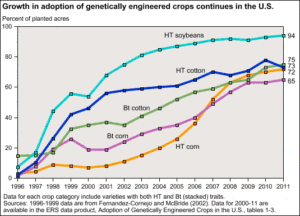USDA – Economic Research Service
Overview
U.S. farmers have adopted genetically engineered (GE) crops widely since their commercial introduction in 1996, notwithstanding uncertainty about consumer acceptance and economic and environmental impacts. In terms of share of planted acres, soybeans and cotton have been the most widely adopted GE crops in the U.S., followed by corn. This data product summarizes the extent of adoption of herbicide-tolerant and insect–resistant crops since their introduction in 1996. Three tables devoted to corn, cotton, and soybeans cover the 2000-11 period by State. See more on the extent of adoption…

Adoption of GE crops has grown steadily in the United States since their introduction in 1996.
Data
The following tables provide the data obtained by USDA’s National Agricultural Statistics Service (NASS) in the June Agricultural Survey annually for 2000 through 2011. Randomly selected farmers across the United States were asked if they planted corn, soybeans, or upland cotton seed that, through biotechnology, is resistant to herbicides, insects, or both. Conventionally bred herbicide-tolerant varieties were excluded. “Stacked” gene varieties are those containing GE traits for both herbicide tolerance (HT) and insect resistance (Bt).
* Corn: genetically engineered varieties by State and United States, 2000-11
* Cotton: genetically engineered varieties by State and United States, 2000-11
* Soybeans: genetically engineered varieties by State and United States, 2000-11
* All tables in one Excel workbook (multiple worksheets)
According to NASS, the States published in these tables represent 81-86 percent of all corn planted acres, 87-90 percent of all soybean planted acres, and 81-93 percent of all upland cotton planted acres (depending on the year). See more on the extent of adoption.
The acreage estimates are subject to sampling variability because all operations planting GE varieties are not included in the sample. The variability for the 48 corn States, calculated by NASS using the relative standard error at the U.S. level, is 0.3-1.8 percent for all GE varieties (depending on the year), 1.6-2.5 percent for insect-resistant (Bt)-only varieties, 1.6-3.8 percent for herbicide-tolerant-only varieties, and 1.0-10.8 percent for stacked gene varieties. Variability for the 31 soybean States is 0.3-0.8 percent for herbicide-tolerant varieties, depending on the year. Variability for the 17 upland cotton States is 0.6-2.2 percent for all GE varieties, 4.6-6.6 percent for insect-resistant (Bt)-only varieties, 2.6-6.6 percent for herbicide-tolerant-only varieties, and 2.0-4.2 percent for stacked gene varieties.
Updates
These tables will be updated with 2011 GE adoption figures in July 2012 once the survey data become available at the end of June 2012.
Data Sources
Check the data glossary for details of the different surveys that provided the data.
Related Resources
Many people are interested in information about the global GE acreage. USDA does not collect these data. Estimates are produced by the International Service for the Acquisition of Agri-biotech Applications (ISAAA) and can be found in the report, Global Status of Commercialized Transgenic Crops: 2010.

